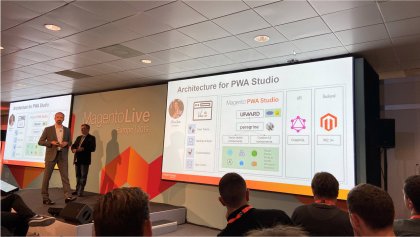The release of Magento 2.3 was hailed by many as great news, thanks in part to an excellent selection of brand new features and improvements that were introduced. For most users, the new native builder and robust warehouse management support were the most important new additions to the Magento 2 roster of features, but today we want to talk about something that is perhaps even more important and useful and that is Magento PWA Studio.
In short, Magento PWA Studio is a set of tools that allow Magento developers to create progressive web apps or PWAs.
What are Progressive Web Apps?
PWAs represent a solution that is meant to bridge the gap between native apps and mobile experience. In short, they are websites that act like apps. They offer the same experience that sites do, but they don’t require the user to download and open an app. For eCommerce, this means your users don’t have to install special apps to be able to shop quickly and seamlessly from your store.
The actual way brands approach PWAs in terms of design and functionalities is different. Some opt to make their PWAs look and feel as close to native apps as possible, with only things such as a browser search bar indicating that it’s not an app but a regular website. Others insist on making the distinction clear, focusing, for example, more on textual content than on visuals.
In most cases, PWA developers aim to create the same shopping experience for users that come to the store from their mobile browsers and for those using the native app.
If that’s the case, a simple question comes to mind – why bother making something look like an app if you already have a perfectly functional and UX-friendly native app?
Why PWA?
Analysts have noticed that people don’t really download apps all that much anymore. When the smartphone revolution first started, everyone was downloading an app for everything, but that trend has slowed in recent years.
Today, people are downloading almost no apps at all. According to statistics, about 50 percent of smartphone users in the USA don’t download any apps at all on a monthly basis, and the other half downloads one or two on an average. Retention has been dropping too, as some 80% of users stop using the app within three months of downloading it.
Mobile users are growing tired of cluttered phones with apps that don’t work and apps they don’t really need. They’re becoming more interested in things that work, however basic or traditional they may seem, and less in flashy apps.
In light of the statistics cited above, and considering that an average Internet user visits approximately 100 websites per month, it is clear that companies had to discover some new kind of common ground, and that’s why PWA was introduced.

PWAs or Native Apps – Which Are Better?
The truth is that there is no easy direct comparison here, especially if we consider that the whole point of PWAs is to work and feel like native apps as much as possible when it comes to user experience.
What is it that people like about apps? Well, they guarantee great performance and are highly reliable. They are highly secure, too, which is essential, of course. Not to mention they come with notifications.
But PWAs are now offering all that plus all the advantages that come with websites. So, from that perspective, it’s clear why they are so attractive both to developers and to merchants.
Let’s take a quick look at some of the things that Magento 2 users can do with PWAs.
Smooth Experience Even When Offline
Before PWAs, only native apps were able to assure offline functionality and guarantee customers a continuous experience even with little or no Internet connectivity. Thanks to a combination of service workers and lightweight caching, PWAs are able to save settings and allow purchases to follow through once a connection is re-established. In addition, PWA offers smart caching for improved user behaviour prediction.
Push Notifications Functionality
Proponents of native apps always stress that push notifications are one of the most important things that separate apps from websites, but with PWA, that is no longer an issue, since they have the same notification features as regular apps, thus assuring the same experience for desktop and mobile users alike.
One-Tap Login and Checkout
Thanks to Web Payments and Credential Management APIs, mobile users can now enjoy smooth and streamlined checkouts, way lighter than the old Magento checkout which used to turn people off and caused a lot of cart abandonment issues. Credential Management offers a one-tap login, as well as auto sign-ins and fast and secure payment.
Splash Screens
Even with PWA, many users facing a website instead of an app may be expecting a cumbersome experience, so Magento merchants might want to put their minds at ease with splash screens that mimic the native app experience, assuring customers that they can expect a seamless shopping experience. Although they are incredibly short (occupying the screen for a fraction of a second), splash screens are incredibly important. The customers will be expecting the browser interface and instead, they will be shown your brand image, capturing their attention and letting them know you are a serious brand that takes care of every single detail.
Home Screen Store Icon
This is another feature that makes sure PWAs mimic the native app experience as closely possible. By allowing customers to add the store icon to their home screen, you’re offering them exactly what the native app experience offers, assuring them that the entire process, from login to checkout, will be as smooth and seamless as it would be with a regular app, and perhaps even better.
Improved Caching for Better Speed
Thanks to a new approach consisting of a combo between service workers, predictive caching, and AMP, PWAs are much faster and lighter than regular websites, another aspect in which they not only mimic the app experience but actually improve on it, offering significantly faster experiences than apps.
In conclusion, progressive web apps are almost certainly going to revolutionize the Magento 2 experience both for the merchants and shoppers. User acquisition is easy, since you don’t have to convince anyone to buy anything, and they don’t need to install anything on their devices. The optimization factor is another important one. PWAs can be made to work faster, offer improved data savings, work better on poor connections, and come with app-like UX characteristics, especially in terms of store navigation.

